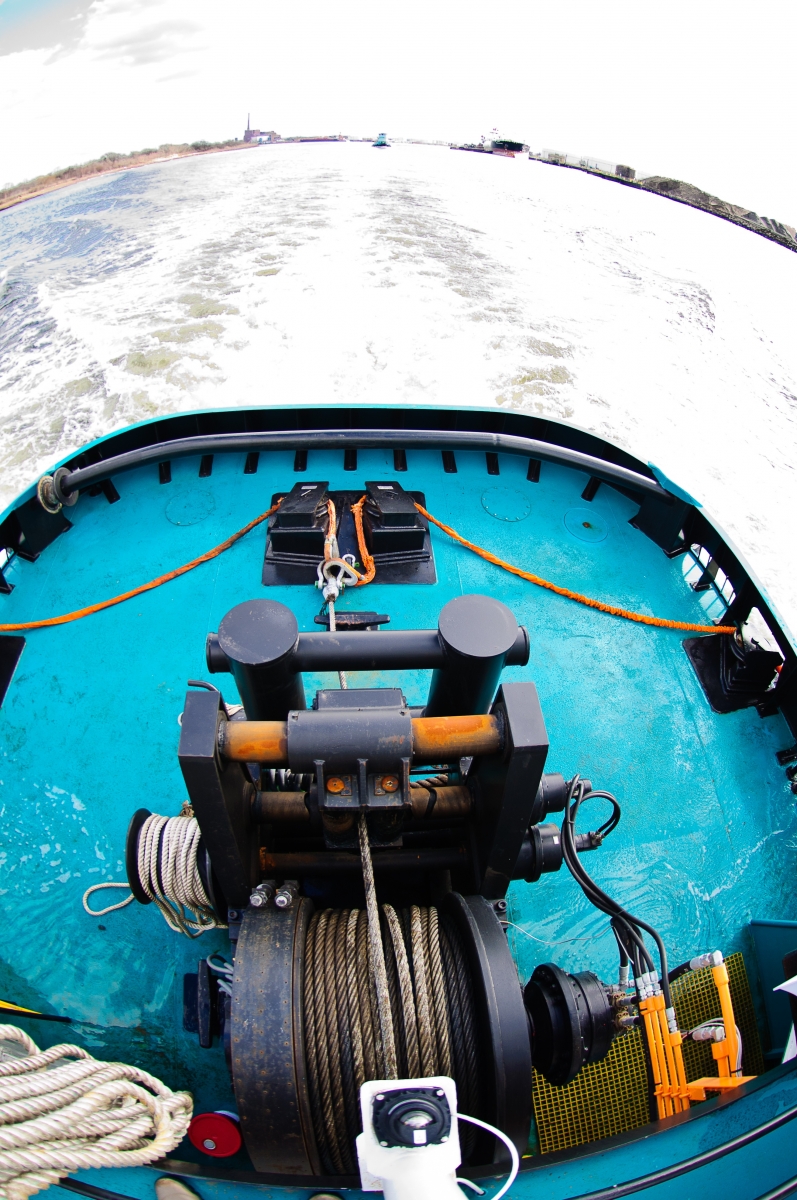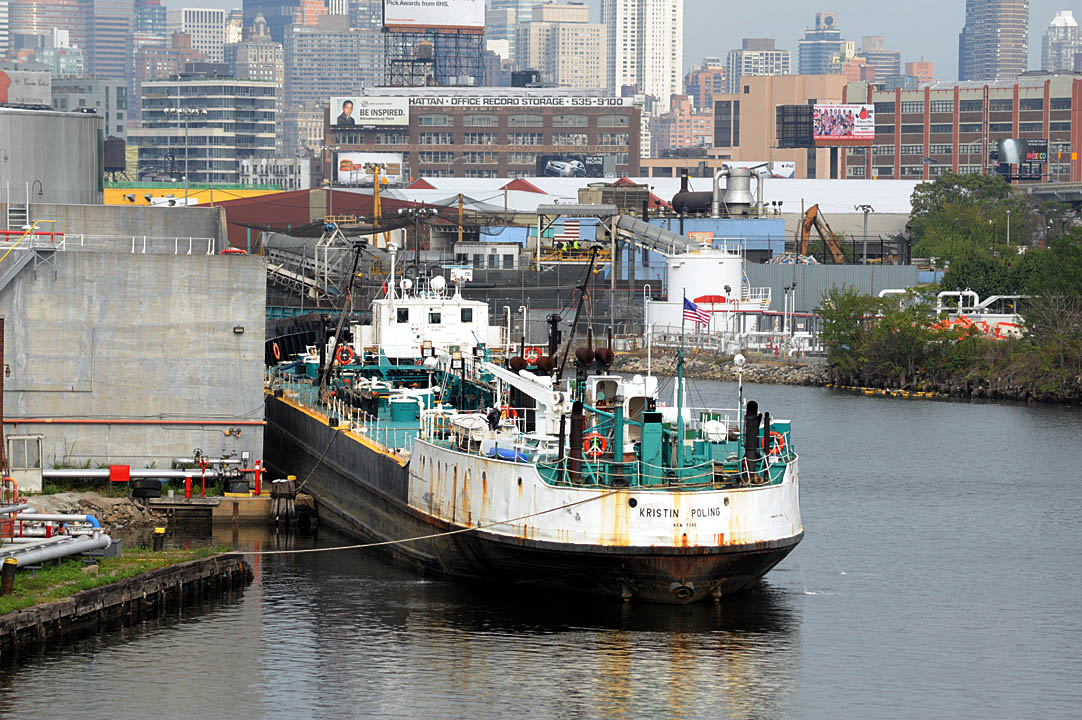She is a small but noteworthy tug playing a big role for a company with a name long connected with New York Harbor.
 |
|
Crystal Cutler, the newest tug to begin work in New York Harbor, passes in front of the Manhattan skyline on her way to pick up the 15,000-bbl clean product barge, Patricia E. Poling. Both are new vessels in the fleet of Poling & Cutler. (Brian Gauvin photo)
|
The 70-foot, 1,500-hp twin-screw tug Crystal Cutler has been pushing and occasionally towing a 15,000-barrel clean oil barge since the tug was introduced in 2010. The tug places a high demand on her captains and crews as she ventures into shallow rivers and estuaries, moving about in a highly dynamic harbor with loads of gasoline, fuel additives or heating oil for small oil terminals.
The conventionally powered tug is operated by Poling & Cutler Marine Transportation, a modern, indirect descendant of the former Poling Transportation Company which, for decades, conducted similar transportation work around New York Harbor and the Northeast. The company, based today in New Jersey, has also introduced several new barges recently and chartered in a good-sized tug from Florida to handle the biggest one.
Poling & Cutler was founded in 1995, roughly the same time as the former Poling Transportation went out of business. Founders of the new company are Ed Poling, whose grandfather started the former Poling company, and Gary Cutler who spent years working in the financial world before getting involved in tugboating.
 |
|
Crystal Cutler makes regular use of her JonRie InterTech towing winch for both pushing and towing.(Brian Gauvin photo)
|
The tug Crystal Cutler was designed by naval architect Frank Basile and colleagues at Entech & Associates, of Houma, La. The tug was built at G&S Marine, Lockport, La. She first arrived in New York Harbor early last summer.
The tug was designed as a shallow-draft, deep-V version of the model bow tugs that are so common around the near-coastal waters of Louisiana and the Gulf of Mexico. With a low bow and minimal sheer, the three-deck tug also has a reasonably elevated pilothouse to provide 28-foot height of eye, good visibility when pushing a light barge around busy New York Harbor. Engine power comes from a pair of Cummins diesels while the tug can tow barges, when necessary, with a JonRie InterTech single-drum towing winch with up to 1,700 feet of wire rope.
The notch of the 15,000-bbl barge Patricia E. Poling was designed to fit the tug's bow as she was built by Trinity Industries of Madisonville, La. The 235-foot double-hull tank barge is engaged mostly with gasoline deliveries with Cummins pump engines, Byron Jackson deep-well pumps and Bergan cargo gauging and alarm systems.
 |
|
Last of her kind, the 77-year old coastal tanker Kristin Poling, shown here in Newtown Creek, is due to be retired from service this summer. (Brian Gauvin photo)
|
New as they are, however, these two vessels are no longer the newsmakers at Poling & Cutler. In late March, Trinity Industries also launched the new 30,000-bbl barge Edwin A. Poling. The tug Kimberly Poling (ex-Jaguar) was to head south to the Gulf to pick up this newly-outfitted barge and tow her back to New York. This 3,000-hp, 15-year-old tug was acquired from Mobro Marine in Florida in 2006. The same tug and barge are expected to be matched up in clean oil service for the foreseeable future, according to the company.
Poling & Cutler also has an 80,000-bbl barge, Eva Leigh Cutler, built recently by VT Halter Marine and currently matched up with the 3,000-hp tug Comet, under charter from Dann Ocean Towing of Tampa, Fla. This is a big vessel with elevated pilothouse and set up for ocean towing as appropriate for an 80,000-bbl barge. The pair are currently on long-term charter to a regular client, according to Cutler.
 |
|
The new 235-foot clean product barge Patricia E. Poling was recently introduced to service. (Brian Gauvin photo)
|
"Yes, it's a lot of big investments for any company," said Cutler. "For the past two years we've been on a growth and replacement campaign and it's been a very capital intense time for us. But with OPA'90 deadlines looming and oil companies really tightening their requirements for double hulls, we have no other choice but to either update or get passed by." Cutler also mentioned that the past few years have also been a time when many Gulf Coast shipyards have been more than willing to negotiate over terms of a building contract, due to economic conditions.
While the company did build one new tug — Crystal Cutler — the emphasis in the building program has been on getting in new barge equipment, said Cutler.
"Barges are the big investments," he said. "We chose to focus on our carrying capacity as we want to build our market share and capacity. If you have work for the barges, then the tugboats will follow," he added.
Poling & Cutler was founded with acquisition of several old vessels either directly from the Poling Transportation Company or at auction as it went through bankruptcy. Today the company employs 43 mariners and administrative professionals, all based in New Jersey. Company vessels, most of them fairly new, are often seen at the piers of Caddell Dry Dock & Repair on Staten Island, N.Y.
In 15 years of quiet but steady growth, the company has changed from operations involving aging motorized tankers with one small oil barge to its present form of being a pure tug-and-barge operation.
 |
|
Dennis Stark, one of the two captains of the new tug Crystal Cutler. (Brian Gauvin photo)
|
The last of the company's coastal tankers, the 281-foot Kristin Poling, is due to be retired this summer. Ed Poling, now perhaps the last person named Poling working in the New York maritime world, began work decades ago aboard Kristin Poling as a summer deck hand while a teenager, and held one of his last jobs with Poling Transportation as captain of the same vessel.
While most such coastal tankers have long since retired, the 77-year-old Kristin Poling sails on — at least for a few more months. Vessels like Kristin, really a motorized barge, used to be commonplace around New York and along coastwise waters from New Jersey to Maine. Another motorized tanker inherited from Poling Transportation Company, Coral Queen, was recently scrapped.
"It will be sad to see the old Kristin go," said Poling. "She has a lot of history and most of the folks who have been around this harbor for a while are familiar with her and with others like her. They are a part of New York's maritime history."
Even though the old tanker could continue operating until the end of 2014, the costs of regular inspections and necessary upgrades and maintenance are prohibitive, said Poling.
Now 62 years old, Poling has let his own U.S. Coast Guard license lapse as his time is largely taken up by management of his new company.
While the company vessels have long delivered gasoline and oil to small terminals located on relatively narrow rivers like the Hutchinson River and Newtown Creek, to name just two, owners Poling and Cutler drew the line recently about servicing an oil terminal inside of the East Rockaway Inlet, located not far from JFK International Airport. Tidal currents running at angles to the channel and shifting sand bars were known to have contributed to a history of groundings at East Rockaway, most without serious oil spill, but the risk is judged to be too much in today's 'zero tolerance' working environment. The soon-to-retire Kristin Poling, in fact, grounded at East Rockaway two or three times over the years and once spent several days stuck there in the sand.
{ |
|
From left to right are Gary Cutler, owner; Pete Bilderback, mate; Dave Manger, engineer; Matthew Thomas, port engineer; Edwin Poling, owner; Dennis Stark, captain; and William Reuben, tankerman. (Brian Gauvin photo)
|
"Our position is that we will no longer run that inlet," said Cutler. "East Rockaway is unforgiving and a number of vessels in the past have not had good outcomes at that location. So, we feel that our company is worth more than the business of that one particular job."
Tankers and tank barges from a number of companies still call at small oil terminals on the infamous Newtown Creek, however. This river which flows out of the heart of Brooklyn and empties into the East River just south of Roosevelt Island, has long attracted freighters, tankers and barges supplying the needs of industry. Hardly a day goes by, actually, without a Poling & Cutler vessel going up the creek to deliver gas or oil to one of several marine terminals located there.
And the newest of this company's tugs, Crystal Cutler, will likely attract the most attention as she delivers her cargoes of fuel to New York's ever-thirsty oil terminals.






